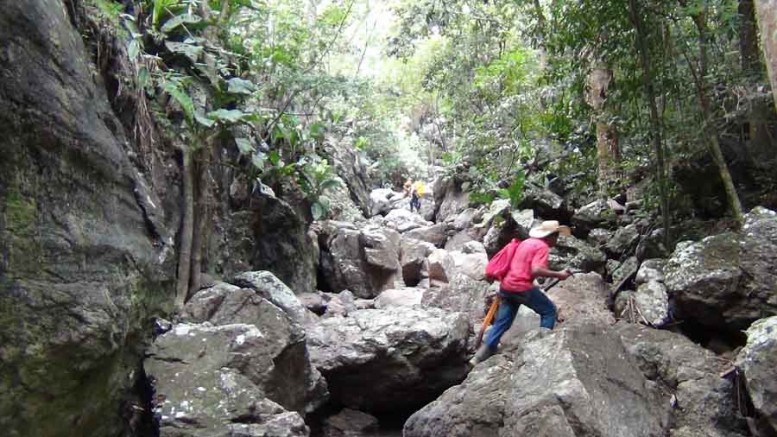Mining in Latin America has had an outstanding period of growth in the last two decades, but is now facing many challenges. These challenges vary from country to country, as well as region to region within each country.
Chile, which is regarded as the best example of a country that is attractive for exploration and mine development, is also experiencing a pushback not only to mine development, but other large projects in other sectors. In Chile, it is becoming harder to permit not only mines, but also hydroelectric projects and even agro-industrial projects that are perceived as having a big environmental signature. This is a reflection of ever-greater social activism, which results in opposition to large mining projects. Because of social media, it is now possible to apply strong pressure to slow or even stop projects.
Peru, the other big star for mining, has also experienced strong social agitation against mining in some parts of the country, especially in 2012, when the Puno area saw major community upheaval against mining activity and a shutdown of exploration in the area. This has been partly the result of Peru having decentralized administrative decision-making to the regions. This devolution was done precipitously, with many regions ill-prepared for that role. This change of the political landscape, combined with much greater social activism of the regions, has resulted in strong mobilization of groups against mining in certain areas. In 2012, Peru enacted legislation that established frameworks for community agreements to carry out exploration. Although more onerous than previous operating conditions, this developed community relationships, confirmed obligations and helped companies go forward.
Illegal mining activities are a major problem throughout South America, and the central governments have been trying to shut down such activities. In Peru, the government is trying to shut down illegal mining in environmentally delicate areas. This is a difficult task, as it is estimated that half a million people are involved in illegal mining, especially concentrated in the environmentally sensitive upper Amazonian basin. The Peruvian government is struggling to have miners formalize their activities, which are not properly registered. Illegal mining is another matter, as this is done in areas such as the Amazon basin. Peru has initiated a program of removing illegal and environmentally damaging small-scale mining activities, and will probably require several years to achieve results.
Colombia has seen similar trends of opposition to mining as elsewhere in the region, however, because of the conflict with illegal groups, post-paramilitary offsprings, criminal groups and guerilla groups, many of the issues are much more complex than in Peru. Mining is resisted in part because it brings competing economic activity, development and state presence to areas where illegality has ruled the roost. Colombia has been in a situation of internal conflict for over 60 years, and this is just one of the many challenges that resulted from this conflict. The FARC, for example, seek land redistribution in rural areas, and a new state with Marxist ideology that would hurt mining opportunity and private investment.
The dynamics of the environmental movements against mining in Colombia, as elsewhere in the developing world, has for its origin a phenomenon of social activism that all large-scale mining is bad. They support small-scale artisanal mining that contaminates the environment much more than modern and large-scale mining. They propose to protect the environment but do not have a strategy of sustainable development, or do not endorse mining as a way of achieving such development. Whilst many environmentalists may have valid grounds for opposing specific projects, environmentalism is frequently used as a cover by Colombia’s illegal armed groups to force miners from their areas of influence or to support left-wing political agendas.
This is what Don Lenihan, a senior associate at the Public Policy Forum in Ottawa, has called “wicked issues.” In his recent paper entitled “When the policy process goes public: Think tanks in the age of complexity” in Policy Options (2011), he states that “this kind of interconnectedness between issues is spreading like a virus. It is a problem for governments because they don’t have adequate tools or processes to deal with it.”
He also notes that “there is almost no discussion of the connection between rising complexity and the declining civility in political debate, though such a connection seems clear.”
The effect of this phenomenon is that governments are less and less able to influence situations by governing to achieve sustainable development.
The Colombian situation
For the last 10 years, Colombia has portrayed itself as a beacon of opportunity to investors in the mining industry.
But there is a gap between the official declarations about the country’s openness to investment and the reality on the ground.
There appear to be a number of reasons why the Colombian investment climate for mining has not been positive:
• Lack of institutional support for the sector
• Lack of a clear mining and environmental policy
• Changing rules, resulting in a lack of legal certainty
• Strong anti-mining socio-political climate
• Government institutions not ready for large-scale mining
• Fragmented and often confusing industry message to government
In his first-term inaugural address in 2010, Colombian President Juan Manuel Santos declared the mining sector as one of his “four locomotives” for the country’s development. Unfortunately, the rails to run that locomotive on were never put in place. As Santos prepares for his second term to begin in August, mining has dropped from his vocabulary, and it seems unlikely it will be a policy priority during his second term.
Lack of institutional support
When mining and exploration investments took off in Chile and Peru, this was the result of a major turning point after periods of no investments because of the Pinochet regime in Chile, which made the country a pariah to investors, and the lack of access in Peru to the countryside because of the long conflict with the Shining Path guerillas.
The resolution of those adverse situations in Chile and Peru was followed by a period where these countries enthusiastically welcomed investments to fill this great vacuum. This was accompanied by strong government support with improvements in the legislative framework to make mining attractive, as well as a conducive social climate. The result was an unprecedented boom of investment in the resource sector in both of these countries, which propelled their economies and development forward.
It was assumed that a similar phenomenon would take place in Colombia with the pacification of the countryside under the Alvaro Uribe government in 2002–10. Although there was improvement in the physical security in many parts of Colombia, and the rural violence was reduced, the conflict did not terminate per se, as it continues in a different form.
Despite an aggressive foreign investment incentive regime to attract investors, the Colombian government was not coherent in its policies.
So that is where the comparison between Colombia and these other two Andean countries no longer holds. Whilst Colombia wanted to attract mining investment, it failed to put a robust, workable mining and enviro
nmental policy in place.
While Peru and Chile followed their difficult period with clear stimulative policies to increase mining investment, and facilitated exploration, this didn’t happen in Colombia because of legal uncertainty and poor mining policies that have been made on-the-hoof.
Bad timing for the locomotive
Colombia entered late in the resource super-cycle and thus only saw the boom part, without understanding the difficult stages of commodity cycles.
The euphoric rush to Colombia in the last eight years by a few of the major mining companies — and more importantly the junior explorers — gave some credence to the idea that the mining “locomotive” was going to take off. The Canadian juniors who had done so well in Peru in the nineties, and in the first decade of the current millennium in Mexico, thought that Colombia would be the next bonanza country. This was seen by the Colombian authorities as proof that their policies were working.
Lack of a clear mining and environmental policy
The Colombian government erroneously assumed that the model for the administrative agency for development that worked for its petroleum sector would be also be good for mining. It therefore set-up the Agencia Nacional de Mineria (ANM), modelled on the National Hydrocarbon Agency in 2012 to replace the INGEOMINAS agency that had been put in place after introducing the 2001 mining law.
This was not good for mining. With the introduction of special reserves and auctions, the agency began to favour policies of state entrepreneurship over improving procedures of mining-titles application procedures. The auctions restricted access to prospective land, as junior explorers didn’t have the financial means to compete. The strategy was initiated in early 2012, with the government withdrawing 210,000 sq. km of prospective land from staking, and establishing it as strategic mineral reserves that were to be auctioned off to the highest bidder.
The Colombian government fails to recognize that junior explorers play an important role in mineral discoveries: risk-taking at the early stage of exploration results in discoveries and generates the projects that are later developed by large mining companies.
Thus, by shutting out juniors, the Colombian government has created an investment climate that has become obstructive. The result is that mining and exploration have been hampered, and as a consequence, many companies have left Colombia.
For investors to be encouraged, mining projects need to move forward to production. That failed to happen in Colombia, in part because most projects started from scratch as greenfield exploration projects that take years to explore and advance. Moreover, a lack of legal certainty and administrative bottlenecks extended the time-scales of all aspects of project exploration and advancement.
Government’s failure to implement a clear project development road map has seriously hampered several projects, such as AngloGold Ashanti’s (NYSE: AU; JSE: ANG) La Colosa project and Eco Oro Minerals’ (TSX: EOM) Angostura project. Other projects have seen drilling programs blocked because of restricted water access (Columbia Metals and Colombia Crest Gold [TSXV: CLB; US-OTC: ECRTF]).
Whereas this period has seen the advancement of many projects to production in Peru and Mexico, this has not happened in Colombia, for a number of reasons. First and foremost is legal uncertainty in the permitting process.
Changing rules and a lack of legal certainty
After the enactment of the antiquated 1989 mining law, ASOMINEROS, the then-principal industry mining association, worked to bring a modern mining code. After previous attempts failed, in 2000, the conditions were finally right to propose a new code.
In 2001, Colombia implemented a modern mining code, which had many of the positive elements to promote the mineral sector. In 2008, there was an initiative by Asomineros/ANDI and later CCM to propose some changes to the Mines Ministry to deal with the law’s shortcomings, such as restrictive limits for the exploration phase, which then had a maximum of five years.
As a gesture of inclusiveness, the then Minister of Mines invited the Minister of the Environment to participate in this consultation, only to have the initiative hijacked by the Ministry of the Environment, which imposed environmental clauses, such as the one making higher elevations — where many mineral deposits are found — off limits to mining. The Environment Minister’s aggressive interference into the mining legislation was motivated by the fact that for the previous 10 years, the Ministry of the Environment had been unable to advance such legislation. So the ministry piggybacked onto the mining legislation, which it knew would not be opposed by the general public. By 2009, there was an open breach between the Ministry of Environment and the Mines Ministry, which resulted in much polarization at government levels. Through manipulation of the media, this spilled over into society at large. Little has happened since to improve this unfortunate situation. This was a “train collision,” where the environmental and mining authorities agendas go in opposite directions.
The passing by decree of the changes (Law 1382) in the Mining Code in February 2010 was followed by its abrogation in May 2012, but the environmental elements were maintained by subsequent application of guidelines of the National Planning Department (Plan Nacional de Desarollo 2011–14), which included the environmental clauses of the abrogated law.
A serious obstacle was the mining claim registry, which to this day does not work. Until recently, it would take years before a company would know whether it had the right to a concession it had staked, whereas in Peru, the process is quick and transparent.
Despite many attempts and promises to improve the staking system, Ingeominas and then the ANM could not establish a workable system. Companies had to wait years to find out the status of titles. By 2012 the government declared long moratoria, at a time when a backlog of over 19,000 claim applications had accumulated. Still, that problem continues.
Cultural and historic factors
Because of the lack of government experience in dealing with large-scale, modern mining, especially in areas such as gold and base metals, there was little understanding of the potential benefits of developing the country.
Chile realized that unexploited mineral resources do not add value to society or produce social benefits. The official preamble to its mining law states: “Immobilized resources that are not extracted do not benefit social development. Thus, for reasons of social development, it is important that resources are not left in the ground as a result of unnecessary restrictions in the mining laws or excess taxation. Legislation must therefore ensure that conditions exist that will result in maximizing of mineral extraction.”
In Colombia, there is no such recognition of the value of mining, nor the understanding of how the government plays a critical role for that to happen. Many Colombians, especially politicians, perceive or seek to portray mining as a destructive and rapacious industry that leaves nothing behind in its wake other than environmental and social depredation. The Colombian popular media largely supports this vision. What contributes to this are several developments.
• Small-scale mining activity has become prominent and the practices damage the environment, especially since law 1382 allows small-scale alluvial mining without a permit. Sometimes mining titles or applications overlap, which increases conflicts, damages and losses.
• The 1991 constitution provides mechanisms that facilitate effective opposition to mining.
• There are numerous initiatives by political groups against open-pit mining, such as the Senate alliance from Huila–Tolima departments, which lobbied against open-pit mining in 2010–11.
• Lack of understanding of large-scale mining.
• Spread of illegal mining that finances activities related to the drug business, as well as guerilla groups.
In Colombia, resource extraction by foreign companies is regarded as a form of neo-colonialism, especially in some sectors of academia. This image is being fostered not only by groups on the left, but also is one of the underlying dogmas of the guerilla and environmental movements, which are especially strongly against foreign mining companies.
There is also concern over mining companies that may not operate responsibly. Unfortunately, there is some basis for this in the coal sector, where Drummond, a private U.S. company, has been sanctioned for the pollution on the Atlantic Coast at Santa Marta, as a result of antiquated coal-loading facilities.
There is also concern about how the company handles social issues in conflict areas. This criticism is based on accusations of past ties of some foreign companies — such as Chiquita — with right-wing paramilitary groups, and allegation of such ties to Drummond. It has to be realized that companies such as Cerrejon, the largest coal producer in Colombia, have excellent track records on the environment and on the social front. Obviously, the press is full of reports on the former and not the latter. The lack of understanding of mining stems from the relative isolation of the country for a long period of time, hence many sectors developed on a small scale, and in the case of the mining industry, only a few large-scale mines in the coal and the ferronickel sectors were developed. The socio-economic framework was not suited for large-scale mine investments.
The general concern about large-scale mining among the population is twofold. They do not like the idea of foreign companies exploiting their resources, but more importantly, there is a feeling that government institutions are not prepared to handle large-scale mining projects.
Constitutional framework
The 1991 constitution, which replaced the 1886 constitution, includes citizens’ tutelage actions, and transfers accusatory judicial review to the attorney general’s office. These changes provide mechanisms for all groups to pronounce upon any issue, as well as making legislators and all government officials reluctant to take what can be perceived as controversial decisions for which they could be held personally liable, even after leaving office.
In March, the Constitutional Court further jeopardized access to mineral titles with Sentence C-123/14, which gives local and regional authorities the ability to withdraw land based entirely on local priorities and politics. This puts at risk the granting of new concessions, which previously was allowed on open ground without such third-party interference.
As intolerance of mining activity in protected areas has grown, and is being capitalized on by vocal environmental groups, the constitution and legislative framework provides the loopholes that can be used to stall development. Unfortunately, these groups do not propose a coherent alternative for sustainable development.
Illegal mining
In Colombia, illegal groups extract over 50% of the gold produced in the country. Much of this money is being used to launder drug money, and in other cases, it is a direct source of financing for illegal groups. Areas where illegal mining takes place are being subjected to great environmental damage, as well as violent and chaotic social conditions because of the emergence of new criminal groups, now euphemistically referred to as “Emerging Criminal Gangs,” or their Spanish acronym BACRIM. These are the offspring of the demobilized paramilitary groups.
The magnitude of this problem has been in the minds of the authorities for the last six years or so, however, it is challenging to deal with this type of mining activity, as there are over 5,000 large pieces of equipment being employed throughout the country. One of the impacts of this activity is that it prevents these areas from being explored or exploited by companies, whether foreign or Colombian, because the areas are not accessible. The case that illustrates this is the 2013 kidnapping by the ELN guerilla group of four geologists and a senior executive from Braeval Mining (renamed Oban Mining [TSX:OBM]) in the town of Norosi, in Bolivar Department. Braeval was forced to give up their mining concessions in order to free their Canadian executive.
Anti-mining entities
With the advent of the exploration boom in Colombia, in several areas of the country there has been a mobilization of active social movements in the form of local civic groups and non-governmental organizations (NGOs) against mining that have drawn support from all sectors of society.
The origin and initial funding of these organizations is hard to trace, but some especially active anti-mining NGOs have been tied with groups from other countries, such as Argentina and Nicaragua. Also little known, although probably significant, is the role of the “Bolivarian Movement,” a left-wing political movement active in Colombia that was financed and promoted by the Hugo Chavez government in Venezuela.
Although often relatively small, these groups have been effective. They catalyzed opposition to mining by mobilizing student marches against a combination of sometimes unrelated issues, but branding them for the press as opposition to mining.
Fragmented mining industry
The mining industry has recognized that it has been a poor communicator both with government and the Colombian public.
The Colombian mining industry has been fragmented when articulating its position before government agencies. Separate organizations represent explorers (CCM) and large mining companies (SGM), with a third representing all sectors including industrial minerals (Asomineros–ANDI). There are also groups representing the aggregate sector, the coal miners, etc. Such a fragmentation of the industry has resulted in poor articulation of the industry’s needs, and an inability to explain its importance and the role the sector could play in developing the country. During the mining law modifications between 2008 and 2010, this lack of a unified voice on the part of the industry was detrimental.
The government has frequently criticized the mining industry for not being able to provide a clear picture of what the sector can do for developing the country, and what it needs from the government in terms of laws and policies for this to happen. In 2010, a large mining organization (SMGE) was formed to address this, but its strategy may not have been in harmony with the group representing explorers, resulting in a more confused message.
In June 2014, the three main industry organizations merged to form the Colombian Mining Association (CMA), or Associacion Colombiana de Mineria (ACM) in Spanish. This should be seen as a positive move.
The future
It can only be hoped that the Colombian government and its people recognize that an opportunity was missed during this last supercycle, and that it takes a more progressive view in preparing the proper groundwork for the future including appropriate mining and environmental policies.
If the current peace process works, mining development will be important to the post-conflict phase, as it is one of the means of advancing much needed rural development and infrastructure.
— Frederick Felder is a Vancouver-based consultant to the mineral sector, and was the executive vice-president of Colombia-focused Greystar Resources (now Eco Oro Minerals) from 2004 to 2011.





Be the first to comment on "Commentary: Why Colombia hasn’t lived up to its mining promise"